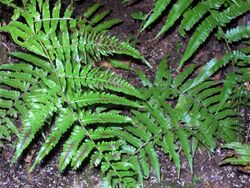Biology:Diplazium
| Diplazium | |
|---|---|

| |
| Diplazium dietrichianum | |
| Scientific classification | |
| Kingdom: | Plantae |
| Clade: | Tracheophytes |
| Division: | Polypodiophyta |
| Class: | Polypodiopsida |
| Order: | Polypodiales |
| Suborder: | Aspleniineae |
| Family: | Athyriaceae |
| Genus: | Diplazium Sw. (1801) |
| Species | |
|
See text | |
| Synonyms[1][2] | |
|
List
| |
Diplazium is a genus of ferns that specifically includes the approximately 400 known species of twinsorus ferns. The Greek root is diplazein meaning double: the indusia in this genus lie on both sides of the vein. These ferns were earlier considered part of either the Athyriaceae, Dryopteridaceae,[3] Aspleniaceae, or Polypodiaceae families or recognized as belonging to their own taxonomic family. The Pteridophyte Phylogeny Group classification of 2016 (PPG I) places the genus in the Athyriaceae.[1] The taxonomy of the genus is difficult and poorly known, and by 2009 has never been the subject of a complete monographic study.[4] Their distribution is pantropical, with a few species extending into temperate areas.[3][5]
The rhizome of the genus Diplazium varies from creeping to erect, and is scaly. Its fronds are deciduous or evergreen, are trophopodic[nb 1] and are either monomorphic or weakly dimorphic. The stipe is green, deeply grooved from above, and is either scaly or glabrous. It always has two lunate vascular bundles. The blades are either singular or in sets of two and are entirely pinnate, range from oblong-lanceolate to deltate, and from herbaceous to papery. It has linear basal sori that are paired back-to-back on the same vein. The indusium is linear and persistent, and the sporangia are brownish.
Some common species include Diplazium hymenodes, the peacock fern; Diplazium esculentum, the vegetable fern; Diplazium molokaiense, the Molokai twinsorus fern; and Diplazium lonchophyllum, the lance-leaved glade fern.
Taxonomy
Diplazium is in the family Athyriaceae in the eupolypods II clade of the order Polypodiales.[6][7] The common glade fern of North America, Diplazium pycnocarpon, is found not to belong to that genus, but rather placed in the genus Homalosorus (Diplaziopsidaceae).[6] Two further species formerly placed in the genus have been transferred to a new genus, Desmophlebium.[8]
Selected species
- Diplazium australe
- Diplazium dietrichianum
- Diplazium dilatatum
- Diplazium esculentum
- Diplazium fraxinifolium
- Diplazium hymenodes
- Diplazium laffanianum
- Diplazium melanochlamys
- Diplazium molokaiense
- Diplazium queenslandicum
- Diplazium sibiricum
Notes
- ↑ The trophopod is food storage organ described from a number of North American ferns. It consists of the enlarged and modified leaf base filled with starch storage tissue. See W. H. Wagner, Jr. and D. M. Johnson, Taxon, Vol. 32, No. 2 (May, 1983), pp. 268-269 for more information on this organ.
References
- ↑ 1.0 1.1 PPG I (2016), "A community-derived classification for extant lycophytes and ferns", Journal of Systematics and Evolution 54 (6): 563–603, doi:10.1111/jse.12229
- ↑ Diplazium Sw. Plants of the World Online. Retrieved 31 August 2023.
- ↑ 3.0 3.1 "3. Diplazium Swartz", Flora of North America, http://www.efloras.org/florataxon.aspx?flora_id=1&taxon_id=110366
- ↑ Leticia Pacheco and Robbin C. Moran. Lectotypification of Several Names Currently Placed in Diplazium (Woodsiaceae). American Fern Journal, Vol. 93, No. 2 (Apr. - Jun., 2003), pp. 90-92
- ↑ {{citation | mode = cs1 | title = Diplazium esculentum | work = Germplasm Resources Information Network (GRIN) | url = https://npgsweb.ars-grin.gov/gringlobal/taxonomydetail.aspx?403231 | publisher = [[Organization:Agricultural Research ServAgricultural Research Service (ARS), United States Department of Agriculture (USDA) | access-date = 12 January 2018 }}
- ↑ 6.0 6.1 Maarten J. M. Christenhusz; Xian-Chun Zhang; Harald Schneider (2011). "A linear sequence of extant families and genera of lycophytes and ferns". Phytotaxa 19: 7–54. doi:10.11646/phytotaxa.19.1.2. http://www.mapress.com/phytotaxa/content/2011/f/pt00019p054.pdf.
- ↑ Alan R. Smith; Kathleen M. Pryer; Eric Schuettpelz; Petra Korall; Harald Schneider; Paul G. Wolf (2006). "A classification for extant ferns". Taxon 55 (3): 705–731. doi:10.2307/25065646. Archived from the original on 2008-02-26. https://web.archive.org/web/20080226232147/http://www.pryerlab.net/publication/fichier749.pdf.
- ↑ Mynssen, Claudine M.; Vasco, Alejandra; Moran, Robbin C.; Sylvestre, Lana S.; Rouhan, Germinal (2016). "Desmophlebiaceae and Desmophlebium: A new family and genus of Eupolypod II ferns". Taxon 65 (1): 19–34. doi:10.12705/651.2. https://www.researchgate.net/publication/297717881. Retrieved 2019-07-26.
Wikidata ☰ Q1802740 entry
 |

